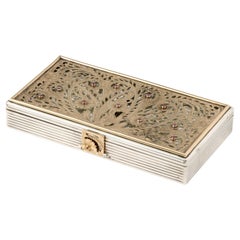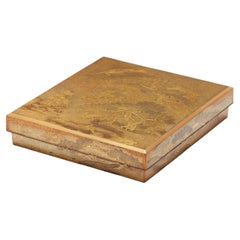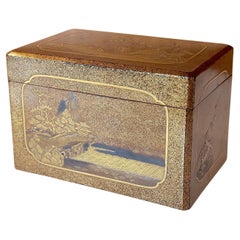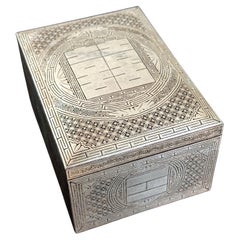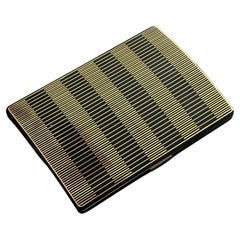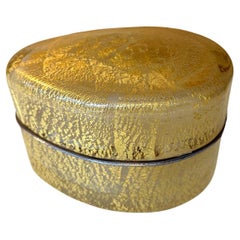TISHU Boxes
to
49
8
16
25
6
15
4
1
2
5
1
2
10
4
3
1
27
24
21
11
8
49
34
34
31
14
14
Height
to
Width
to
49
49
49
11
3
1
1
1
Oversized Vintage French Silver Compact Case by Boucheron
By Boucheron
Located in Atlanta, GA
A large silver compact case with gilt surface and inset rubies by Boucheron Paris circa 1930s-1940s, of Art Deco period and style. The silver case is quote large compared to similar ...
Category
Mid-20th Century French Art Deco Jewelry Boxes
Materials
Multi-gemstone, Silver
Antique Japanese Ink Stone Maki-e Lacquer Box Suzuribako Edo Provenance
Located in Atlanta, GA
A Japanese ink stone box (known as Suzuribako) with exquisite maki-e decoration from Edo period (circa mid-18th century). The box features a rectang...
Category
Antique 18th Century Japanese Edo Lacquer
Materials
Wood, Lacquer
Exquisite Japanese Lacquer Maki-e Hand Box Kobako Edo Period
Located in Atlanta, GA
An early Japanese lacquer Maki-e decorated kobako (small storage box) circa 18th century (Edo period). Based on its form and size, this kobako was possibly used as a Chabako to store the accoutrements for chado (tea ceremony). The lidded box is of rectangular form with bevel design on all edge that softens the appearance. The entire surface was densely covered with a background of nashiji. Elaborate Maki-e techniques were used on each side to showcase a distinct landscape or floral design within a cartouche panel. On the surface of the lid, a mountainous landscape rises from the edge of the water. The poetic composition is akin to a traditional ink scroll...
Category
Antique 18th Century Japanese Edo Lacquer
Materials
Lacquer
Fine Korean Box with Tray Iron with Silver Inlay Joseon Dynasty
Located in Atlanta, GA
A fine Korean iron box with intricate silver inlay dated to the late Joseon Dynasty circa 19th century. The body of the box is made from iron of a heavy weight although the wear on t...
Category
Antique 19th Century Korean Other Metalwork
Materials
Silver, Iron
French Art Deco Enamel and Gilt Box by Van Cleef & Arpels
By Van Cleef & Arpels
Located in Atlanta, GA
An Art Deco style enamel and gilt metal box made by French Jeweler Van Cleef & Arpels circa 1930s. The box was most likely used for cigarette (and small bills) and it has an elegant ...
Category
Vintage 1930s French Art Deco Decorative Boxes
Materials
Metal
Japanese Kazaribako Glass Box Kyohei Fujita
By Kyohei Fujita
Located in Atlanta, GA
A Kazaribako "Ornamented Box" made of glass by Japanese artist Kyohei Fujita (1921-2004) circa 1980s. The hand-blown glass box with fitting lid is of an oval shape, slightly irregula...
Category
Vintage 1980s Japanese Modern Glass
Materials
Silver
Antique Japanese Lacquer and Inlay Table from Ryukyu Islands
Located in Atlanta, GA
A small square-form table with lacquer and intricate mother-of-pearl inlay design from Ryukyu Islands kingdom circa 17-18th century. Ryukyuan kingdom was used to be an independent is...
Category
Antique 18th Century Japanese Edo Lacquer
Materials
Mother-of-Pearl, Lacquer
Antique Japanese Lacquer and Inlay Kang Table from Ryukyu Island
Located in Atlanta, GA
A small low table with lacquer and intricate mother-of-pearl inlay design from Ryukyu Islands kingdom circa 17-18th century. Ryukyuan kingdom was used to be an independent island cou...
Category
Antique 18th Century Japanese Edo Lacquer
Materials
Mother-of-Pearl, Lacquer
Large Japanese Kazaribako Glass Box Ancient Captial Kyohei Fujita
By Kyohei Fujita
Located in Atlanta, GA
A Kazaribako "Ornamented Box" made of glass by Japanese artist Kyohei Fujita (1921-2004) circa 1990s. The hand-blown glass box is substantial in size and weight. It features a hexago...
Category
1990s Japanese Modern Glass
Materials
Silver
Japanese Kazaribako Glass Box Rare Hagoromo Kyohei Fujita
By Kyohei Fujita
Located in Atlanta, GA
A brilliant Kazaribako "Ornamented Box" made of glass by Japanese artist Kyohei Fujita (1921-2004) circa 1990s. The hand-blown green glass box featur...
Category
1990s Japanese Modern Glass
Materials
Silver
Japanese Lacquer Maki-E Scroll Box Fubako by Kansonsai Edo Period
Located in Atlanta, GA
A Japanese lacquered wood fubako (a box to store document or small scroll painting) circa late 18th century of Edo period. The rectangular box features a deep lid with rounded corners and recessed mid-edge and a lower box with two bronze medallion rings and tasseled silk ties. The surface of the fubako was elaborately decorated with hiramaki-e and a low takamaki-e on a mottled Mura-nashiji background. The motifs on the lid depict branches of Japanese pine with finely rendered needles on the lower part; on the upper part, it showcases fruited persimmon branches. Two different shades of gold fundame were used to contrast the design and augmented by scattered gold kirigane to highlight some of the leaves. The design continues and cascades down to all sides of the lid as well as the walls of the box. The two bronze medallions appear original to the box and the silk ties show significant fading from the age. This Fine fubako is signed on the lower wall "Kanshosai" in Kanji with a kao mark. All the trims were finished in gold fundame and the interiors a dense nashiji in gold.
Kanshosai is the mark of the distinguished lacquer artist Lizuka Toyo I who also signed his work "Toyosai". He was active in the second half of the 18th century during Edo period, employed by Hachisuka Shigeyoshi (1738-1801), daimyo of Awa on Shikoku Island. Although most survived work bearing his marks are inros, he was also known to decorated trays and other larger objects...
Category
Antique Late 18th Century Japanese Edo Lacquer
Materials
Wood, Lacquer
Fine Korean Iron Box with Silver Inlay Joseon Dynasty
Located in Atlanta, GA
A fine Korean iron box that was traditionally used to store tobacco leaves dated to the late Joseon Dynasty circa 19th century. The box is made from iron and has a heavy weight, although the wears along the edges of the lid and base exposes a bronze metal color underneath, indicating the iron metal may contains a high level of copper. The surface was beautifully decorated with elaborate silver inlay that covers the entire surface except the base. The extraordinary workmanship depicts a pair of deer within the circled square (shape of heaven and earth) and a lined background on the long sides and a crane with spread wings on the shorter sides. Both animals were associated with longevity. Their eyes were highlighted with copper inlay, adding a lively touch to the animation. The lid is centered with a Chinese character "Xi" (Paired-Hui in Korean), which means double happiness. (In Chinese culture, it is often used in a wedding ceremony). The large symbol was set on geometrical background of tightly scrolling diamond pattern surrounded by stylized Ruyi mushroom heads, another floral longevity symbol. Archaic fret cloud band borders the entire perimeters of the lid and the container.
Tobacco was introduced to Korean in the first half of the 17th century and gradually gained popularity. When the tobacco was started being smoked in shredded form instead of rolled leaves, there rose the production of the smoking accessories, with some in fine quality as luxury items for the elite. The accoutrement such as this box is a fine example made in late Joseon dynasty, using extensive silver inlay, a technique called "jjoeum-ipsa", in which the silver wires were hammered into the scorched iron surface to create the elaborate design.
Similar boxes with variation of shape and motifs are in the collection of several major museums. Compare the box with item Gu 754 in the National Museum of Korea; item 22.78 in MET NYC and M.240:1, 2-1926 in V& A Museum in London. The most closely related example we found is item C232 in the collection of the Museum of East Asian Art...
Category
Antique 19th Century Korean Other Metalwork
Materials
Silver, Copper, Iron
Large Rare French Gilt Bronze Box "Pinocchio" by Line Vautrin
By Line Vautrin
Located in Atlanta, GA
A rare cast gilt bronze box "Pinocchio" by French Parisian art jeweler Line Vautrin (1913-1997). The elongated lidded box depicts a silouette portrait of the famous boy. The interior...
Category
Vintage 1940s French Mid-Century Modern Decorative Boxes
Materials
Bronze
Fine Miniature Japanese Kodansu with Lacquer Inlays
Located in Atlanta, GA
A fine Japanese miniature kodansu constructed from Kaki wood (Persimmon) circa 19th century, late Meiji period. With its expressive exotic wood grains and exposed tenon construction,...
Category
Antique Late 19th Century Japanese Meiji Lacquer
Materials
Wood
French Line Vautrin Bronze Poem Box with Sonnet by Felix Arvers
By Line Vautrin
Located in Atlanta, GA
A wonderful jewelry box in gilt cast bronze by Parisian art jeweler Line Vautrin (1913-1997). From a small special series, the designer created circa 1945-55. on which some French poems were cast in relief on the cover. This box features a well-known love poem "Sonnet" by Félix Arvers (1806 – 1850), widely considered as one of the most romantic French poems written about unrequited love and longing. Three out of four passages are shown on the lid except the third one. The box is lined with cork. There is a line on the back from casting, commonly seen in the boxes of the series.
Mon âme a son secret, ma vie a son mystère,
Un amour éternel en un moment conçu
Le mal est sans espoir, aussi j'ai dû le taire,
Et celle qui l'a fait n'en a jamais rien su.
Hélas ! j'aurai passé près d'elle inaperçu,
Toujours à ses côtés, et pourtant solitaire.
Et j'aurai jusqu'au bout fait mon temps sur la terre,
N'osant rien demander et n'ayant rien reçu.
Pour elle, quoique Dieu l'ait faite douce et tendre,
Elle suit son chemin, distraite et sans entendre
Ce murmure d'amour élevé sur ses pas.
À l'austère devoir, pieusement fidèle,
Elle dira, lisant ces vers tout remplis d'elle
" Quelle est donc cette femme ? " et ne comprendra pas.
A secret fills my soul, and a mystery fills my life,
An eternal love conceived in an instant.
As the scourge was hopeless, it remained wordless,
And the one responsible was unaware of it.
Alas! I lived close to her but without notice,
Always by her side yet so lonely.
And I shall have lived my days on this Earth,
Not daring to ask for anything, obtaining nothing.
Even though God made her gentle and tender,
She goes her way, careless and oblivious
To the sough of love rising...
Category
Mid-20th Century French Mid-Century Modern Decorative Boxes
Materials
Bronze
Japanese Maki-e Lacquer Portable Sagejubako Theme of Three Winter Friends
Located in Atlanta, GA
Sagejubako is a portable lunch or picnic set that became popular in the early Edo period when an additional meal was added between breakfast and dinner. It normally consists of a han...
Category
Antique 19th Century Japanese Japonisme Lacquer
Materials
Lacquer
Gilded Bronze Box with Poem by French Art Jeweler Line Vautrin
By Line Vautrin
Located in Atlanta, GA
A gilt bronze poudrier box with cast poem on surface by Parisian art jeweler Line Vautrin (1913-1997) circa 1940s. The poem "Les 4 ages de la Femme" was an old French lyrical poem th...
Category
Vintage 1940s French Mid-Century Modern Decorative Boxes
Materials
Bronze
French Silvered Bronze Box Line Vautrin
By Line Vautrin
Located in Atlanta, GA
A silvered bronze Poudrier "Le loup et le renard" (The wolf and the fox). by Parisian art jeweler Line Vautrin (1913-1997) circa 1940s. The square box features a relief cast of two s...
Category
Vintage 1940s French Mid-Century Modern Decorative Boxes
Materials
Bronze
Large Gilt Bronze Feuille Box by Line Vautrin
By Line Vautrin
Located in Atlanta, GA
A large cast bronze powder box (poudrier) by French Parisian art jeweler Line Vautrin (1913-1997) circa 1945-1950. The box called "Feuille" (Leaf) features an irregular leaf form wit...
Category
Vintage 1940s French Mid-Century Modern Collectible Jewelry
Materials
Bronze
Silvered Bronze Box with Relief Cast Poem by Line Vautrin
By Line Vautrin
Located in Atlanta, GA
A wonderful jewelry box in silvered cast bronze by Parisian art jeweler Line Vautrin (1913-1997). From a small special series, the designer created circa 1945-55. on which poems were cast in relief on the cover. Most existing examples features poems that are well-known. This poem, however, was not identified by us, and possibly is a creation of the artist herself. It is a very soulful prose (see the full poem in French below). Signed on the base as shown.
We have a gilt bronze box with the same relief cast poem that comes with a three-page Certification in French by Comite Line Vautrin, shown in some photos as well.
Reference: For other boxes with poems see "Line Vautrin Sculptor, Jeweller, Magician by Line Vautrin and Patrick Mauries, page 42.
"Les glaciers vagabonds qui ébranlent les murs
et les anges frileux qui cherchent un asile quand la nuit de décembre
anesthésie la ville t’effraient plus que les morts tutélaires et durs
Ils désertent pour toi...
Category
Mid-20th Century French Mid-Century Modern Decorative Boxes
Materials
Bronze
Antique Japanese Lacquer and Inlay Box from Ryukyu Island
Located in Atlanta, GA
A lacquer presentation box with mother-of-pearl inlays from Japanese Ryukyu Islands circa 17-18th century. The lidded box in rectangular form with rounded corner is a classic example...
Category
Antique 18th Century Japanese Japonisme Lacquer
Materials
Mother-of-Pearl, Lacquer
Japanese Rinpa Style Lacquer Ink Stone Box Suzuribako
Located in Atlanta, GA
A Japanese writing box with ink stone (known as Suzuribako) with exquisite maki-e decoration circa late Meiji to early Taisho period (1890s-1930s)...
Category
Early 20th Century Japanese Japonisme Lacquer
Materials
Wood, Lacquer
Japanese Maki-e Lacquerware Portable Picnic Set Sagejubako
Located in Atlanta, GA
Sagejubako is a portable picnic set that became popular in the early Edo period when an additional meal was added between breakfast and dinner. It normally consists of a carry case w...
Category
Antique 19th Century Japanese Japonisme Lacquer
Materials
Lacquer
Rare Japanese Lacquer Writing Box Suzuribako Meiji Period
Located in Atlanta, GA
A Japanese Lacquer writing box Suzuribako Meiji Period (1868-1912), likely circa late 19th century. This suzuribako is one of the most unusual boxe...
Category
Antique 19th Century Japanese Japonisme Lacquer
Materials
Lacquer
Large French Silvered Bronze Box Line Vautrin
By Line Vautrin
Located in Atlanta, GA
A silvered bronze poudrier box "Ammonite" by French Parisian art jeweler Line Vautrin (1913-1997).
In the 1940s, Line Vautrin designed a series that was inspired by the shape of na...
Category
Mid-20th Century French Mid-Century Modern Decorative Boxes
Materials
Bronze
Large French Sculpted Bronze Box by Line Vautrin
By Line Vautrin
Located in Atlanta, GA
A large bonze box (based on the size, it is likely a card case) by French Parisian art jewelry designer Line Vautrin (1913-1997) circa 1950s. The box features an interesting design i...
Category
Mid-20th Century French Mid-Century Modern Decorative Boxes
Materials
Bronze
Japanese Lacquer Ryoshibako Document Box Meiji Period
Located in Atlanta, GA
A large Japanese lacquer box with elaborate Maki-e design from Meiji period, (mid-late 19th century). The generous size of the box was reser...
Category
Antique 19th Century Japanese Japonisme Lacquer
Materials
Wood, Lacquer
Gilt Bronze Reliquary Pendant by Line Vautrin
By Line Vautrin
Located in Atlanta, GA
A piece of wonderful jewelry by Line Vautrin designed in 1941 on the subject of St Foi, a child martyr on the early fourth century and the patron saint of prinsoers, in a rare form of a reliquary...
Category
Vintage 1940s French Mid-Century Modern Collectible Jewelry
Materials
Bronze
Cartier Art Deco Sterling Silver Compact Case by
By Cartier
Located in Atlanta, GA
A fine Cartier compact case in Art Deco style, circa 1930s. Sterling silver with gold gilt interior. The exterior features engraved line pattern that r...
Category
Vintage 1930s French Art Deco Decorative Boxes
Materials
Silver
Japanese Cloisonné Covered Jar by Ando Jubei
By Ando Jubei
Located in Atlanta, GA
Japanese cloisonné enamels are known as shippo-yaki and the mid-19th century saw the production of very high quality wares in the early centers Nagoya. One of the most renowned works...
Category
Early 20th Century Japanese Japonisme Metalwork
Materials
Metal, Sterling Silver, Enamel
French Sculptured Gilt Bronze Box by Line Vautrin
By Line Vautrin
Located in Atlanta, GA
A gilt bronze box or podier by French Jeweler Line Vautrin, in the pattern of "Moise ou la traversee du desert" coric 1940s-1950s.
A rare mode in the box, the top surface of the cover illustrates the biblical story of Moses crossing the desert out of Egypt...
Category
Mid-20th Century French Modern Decorative Boxes
Materials
Bronze
Japanese Rinpa Style Lacquer Box Meiji Period
Located in Atlanta, GA
A black lacquer tebako (hand box) with maki-e decoration and silver trim, circa late 19th century, Meiji period. The surface of the lid features a Rinpa style maki-e paint depicting ...
Category
Antique 1890s Japanese Japonisme Lacquer
Materials
Wood, Lacquer
Japanese Lacquer Box with Fine Maki-e Decoration Meiji Period
Located in Atlanta, GA
A lacquered wood box with lid from Japan circa 19th century Meiji Period. The finely decorated box was used to store paper slips and small documents on the desk. It is overall finished with black lacquer (kuro) with sparse Mura-Nashiji effect outside and on the top surface of the lid, there are three Komainu, (sometimes known as Shishi or Japanese lions) frolicking and forming a circle in lively motion. Komainu are auspicious animals in Japanese cultures in both Shinto and Buddhism tradition. Originally from China, these animals symbolizes guardians to ward off evil spirits. Hiramaki-e was used in combination with carving and combing to render the lions with various surface textures. A gilt border with an slight angle was given to the lid and even the thin band is decorated with miniature floral scrolls. The interior of the box was finished in a dense nashiji. Underneath the lid, a cluster of peonies open lavishly by two gentle mounts. Takamaki-e (high relief) in both gold and silver were...
Category
Antique Late 19th Century Japanese Japonisme Lacquer
Materials
Wood, Lacquer
Fine Japanese Lacquered Inro with Inlays by Kajikawa
Located in Atlanta, GA
A Japanese four-case lacquer inro by a member of Kajikawa family circa 19th century (late Edo to early Meiji period). It depicts a nocturnal scenery of a meandering stream surrounded by bush clovers, where a full moon is reflected on the water. It was masterfully decorated in gold and silver maki-e using a combination of techniques including takamakie, togidashi and kirigane as well as aogai (abalone shell) inlays. The stream was set between the slightly elevated banks, adding to this piece a already strong three-dimensional composition. The interior was decorated in gold nashiji. It was signed on the bottom "Kajikawa Zou" (made by Kajikawa and a pot seal centered with "Ei" in Kanji. In one of the compartment, there is a katakana mark, appears to be a name, possibly the owner.
Kajikawa clan was one of the most famous lacquer artisanal family established in the 17th century. Many well known members over the generations produced lacquer art in a wide range of formats, but two third were signed only with the family name such as this one. It is therefore not possible to pinpoint the exact author of this piece.
Provenance: This inro was purchased as lot 349 in Christie's New York sale Japanese...
Category
Antique 19th Century Japanese Japonisme Lacquer
Materials
Shell, Wood, Lacquer
Fine Japanese Lacquered Inro by Yutokusai
Located in Atlanta, GA
A four-case lacquered Japanese inro by Yutokusai (Gyokkei), a lacquer artist active from 1845-1900 (end of Edo to Meiji period). The slightly round inro features a very intricate design with three unfolded fans on the front and two on the back: each reveals a vignette landscape scenery, likely real places in Japan. Using a combination of hiramaki-e and slight takamaki-e, the artist deftly created the pictures with fine details, rendering the inro as a miniature artwork...
Category
Antique 19th Century Japanese Japonisme Lacquer
Materials
Wood, Lacquer
Antique Japanese Inro by Shigehide Edo Period
Located in Atlanta, GA
This exquisite four-case lacquered inro was dated to the latter part of 18th century to early 19th century (Edo period) and made by Shigehide. The opposite sides of the inro together features a lavish flower arrangement in a bamboo basket (ikebana). The detailed craftmanship was a true pleasure to behold. Mostly Takamaki-e (high relief) were used to texturize the delicate petals of the chrysanthemums, on which different shades of gold were used to create contrast. Raden (mother of pearl) shells were also used to highlight some leaves, rendering the piece an interesting balance of color and material. The interior was completed in a mottled gold finish. It was signed Shigehide on the bottom with a Kao. There is a small carved rabbit ojime bead...
Category
Antique Late 18th Century Japanese Japonisme Lacquer
Materials
Wood, Lacquer
Japanese Inro by Koma Koryu Edo Period
Located in Atlanta, GA
A four-case lacquered inro by Koma Koryu circa 19th century late Edo period. The inro features a pair of Chinese mandarin duck resting under a bundle of blooming irises on the pond. ...
Category
Antique 19th Century Japanese Japonisme Lacquer
Materials
Wood, Lacquer
Unusual Japanese Lacquer Inkstone Box with MOP Inlays
Located in Atlanta, GA
A Japanese black lacquer box with mother of pearl inlays circa early 20th century, end of Meiji period. It was likely to be used to store inkstone or other scholarly items. The piece displays several interesting characteristics that appear puzzling initially. First, the form is not typical Japanese, but more Chinese and Korean, with its scalloped base. Second, the decoration of MOP inlays also suggests a Korean and Chinese affiliation, especially with the linear borders and the scrolling cloud patters on the sides of the box. These two observations suggest that the box may be from Ryukyu Island instead of Japanese mainland. Third, strikingly in the center of the cover, a bold quarterly floral pattern outlined with MOP was filled with a striking mottled red lacquer using tsugaru nuri...
Category
Early 20th Century Japanese Japonisme Lacquer
Materials
Wood, Lacquer
Japanese Maki-e Lacquer Stack Box Jubako
Located in Atlanta, GA
An antique jubako (stack boxes) with five tiers in an elongated octagon shape circa 19th century (end of Edo or beginning of Meiji period). jubako was traditionally used to store and...
Category
Antique 19th Century Japanese Japonisme Lacquer
Materials
Wood, Lacquer
Japanese Lacquer Maki-e Sake Ewer Meiji Period
Located in Atlanta, GA
A Japanese lacquered wood sake ewer with maki-e design, circa late 19th century, Meiji period. The nicely decorated lacquerware is of a Classic sake ewer for...
Category
Antique 1890s Japanese Japonisme Lacquer
Materials
Lacquer
Pair of Large Antique Japanese Hokai Lacquer Boxes
Located in Atlanta, GA
A pair of Japanese lacquer lidded Hokai boxes with chased brass hardware and original ropes. Hokai boxes are traditionally used in Japan to store and carry s...
Category
Early 20th Century Japanese Japonisme Lacquer
Materials
Wood, Lacquer
Vintage Korean Lacquer Box with Inner Tray and MOP inlays
Located in Atlanta, GA
A lovely vintage Korean lacquer box in bright red and decorated with mother-of-pearl inlays circa 1970-80s. The square form box features an auspicio...
Category
Late 20th Century Korean Arts and Crafts Lacquer
Materials
Mother-of-Pearl, Lacquer
Antique Japanese Lacquered Incense Box Kobako Ex-Christie's
Located in Atlanta, GA
An old Japanese lacquered small box likely used to contain incense powder called Kobako, circa Momoyama to early Edo period (16-17th century). The rectangular form box with a fitted ...
Category
Antique 17th Century Japanese Japonisme Lacquer
Materials
Lead
Japanese Antique Lacquer Maki-E Miniature Hasami-Bako with Copper Mounts
Located in Atlanta, GA
A Japanese lacquered box with lid in the shape of a miniature Hasami-Bako (traveling chest) circa late 18 to early 19th century of the Edo period....
Category
Antique Early 19th Century Japanese Japonisme Lacquer
Materials
Copper
Brutalist Metal Patchwork Box with Insert Paul Evans
By Paul Evans
Located in Atlanta, GA
A cube form desktop box covered with patchwork copper by American artist and designer Paul Evans (1931-1987). The lidded box has a plastic insert box and was made as an ice box or a ...
Category
Mid-20th Century American Brutalist Decorative Boxes
Materials
Metal
Pair of Large Antique Japanese Hokai Lacquer Boxes
Located in Atlanta, GA
A pair of Japanese lacquered lidded Hokai boxes with chased brass hardware and original ropes. Hokai boxes are traditionally used in Japan as the containers ...
Category
Early 20th Century Japanese Japonisme Lacquer
Materials
Wood, Lacquer
Japanese Lacquer Maki-E Tiered Suzuribako and Ryoshibako
Located in Atlanta, GA
A Japanese roiro lacquer scholar combo box with an upper tier of inkstone box (Suzuribako) and a lower document box (Ryoshibako) circa 1910-30s (end of Meiji to Showa period). The high glossy box was beautifully decorated with an image of the famously eccentric Buddhist monks Hanshan and Shide (known in Japan as Kanzan and Jittoku). Often as a pair, they have been a popular motif in Japanese Zen painting...
Category
Vintage 1920s Japanese Meiji Lacquer
Materials
Stone, Metal
Rare French Small Gilt Bronze Box by Line Vautrin
By Line Vautrin
Located in Atlanta, GA
A small gilt bronze pill box by French Parisian art jeweler Line Vautrin (1913-1997) circa 1940-50s. The rather rare round box features a relief-cast spider on the lid. The interior ...
Category
Mid-20th Century French Mid-Century Modern Decorative Boxes
Materials
Bronze
Antique Japanese Lacquered Incense Box Kobako in Kodaiji Style
Located in Atlanta, GA
An antique lacquered small box that was likely used to contain incense powder (it is called Kobako in Japanese), circa early to mid-19th century of the Edo...
Category
Antique 19th Century Japanese Edo Lacquer
Materials
Wood, Lacquer
